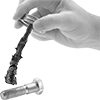Filter by
For Wire Gauge
Wire Connection Method
Input Voltage
Switching Voltage
Wire Connection
Mounting Location
Switching Current
Actuator Style
Switch Designation
Certification
Voltage
Export Control Classification Number (ECCN)
DFARS Specialty Metals
Electrical
Fastening and Joining
Lighting
Lubricating
Communication
Raw Materials
Power Transmission









































































